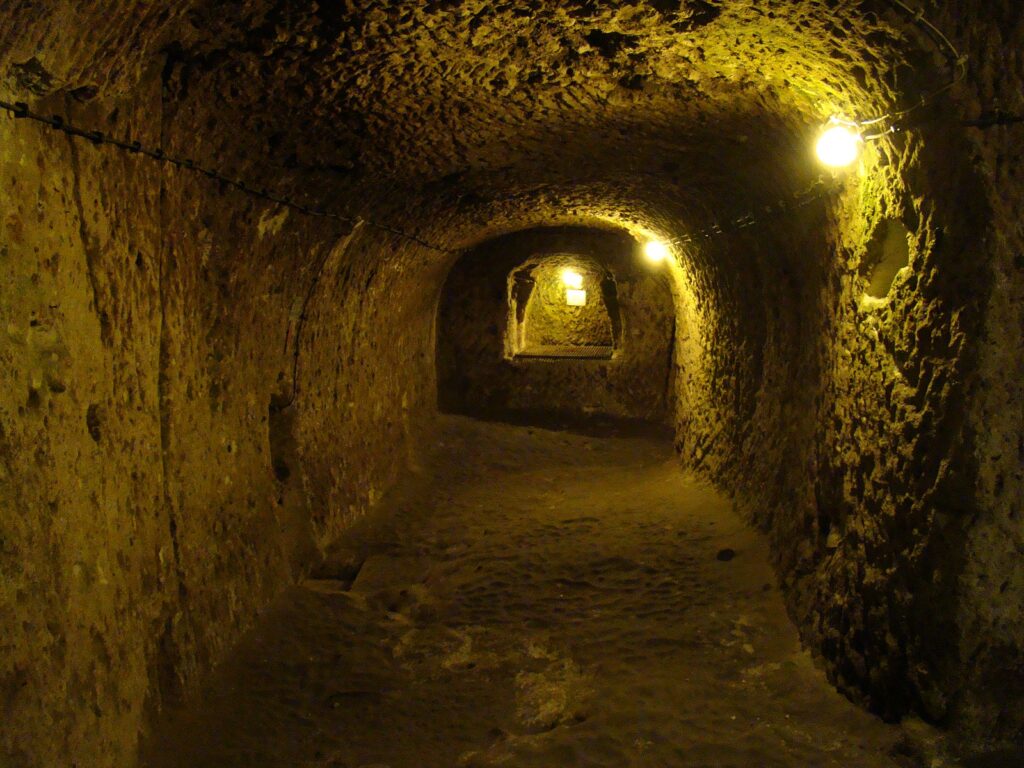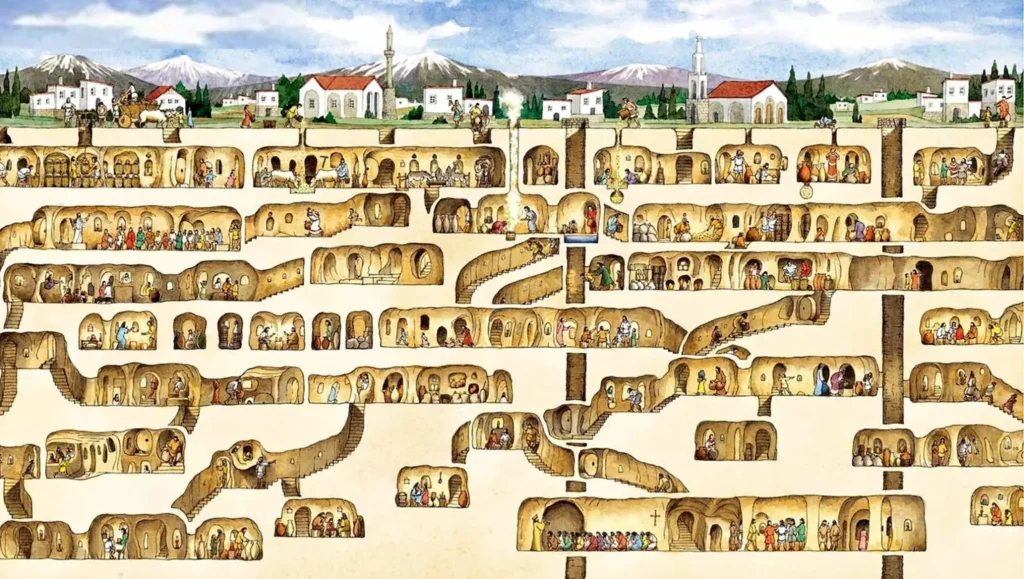It’s one of the strangest and most startling discoveries ever made. A man wanting to make some changes to his basement took a sledgehammer to a wall and couldn’t believe what was behind it.
Just like Andy Dufresne found a sewer that extended five football fields outside of Shawshank prison after digging his way through a wall, an anonymous Turk discovered a tunnel leading to an underground city that housed more than 20,000 people!
Located in the Nevsehir Province of Turkey, the underground city in Derinkuyu was 280 feet (85 meters) below the ground. Historians say it could stored up to 18 floors in a building.
But what’s even more incredible is it was one of more than 200 cities beneath the Anatolian Plains. Derinkuyu was the largest.
While it’s now a popular tourist attraction, thousands of years ago it was used as a hiding place during wars and a haven for those wanting to escape the battles outside. It began with someone noticing soft rock and soon turned into one of the biggest excavation projects in the history of mankind.

The Discovery
In 1963, a young Turkish man kept losing his chickens. He decided to remodel his home in the process. As he was remodeling, he discovered the chickens were finding small crevices in his home to escape.
So the man decided to take a sledgehammer and dig to find out where they were going. What he found was more than just a small crevice. He found a tunnel that led to an underground city…and it was big.
Uncovered were empty schools, cattle stables, wineries, chapels, food storage areas, dwellings, offices, storage rooms, and more. It was a massive underground city that could fill up to 18 floors. There were 600 entrances to underground private homes that were found.
More than 15,000 shafts ventilated the underground city, with each shaft about 10 cm wide, enough to reach down to the first and second levels. Since the upper quarters received the most ventilation, they were used for sleeping rooms.
The lowest levels with the least amount of air were used solely for storage and even contained a dungeon. On the seventh level, there was a cruciform church.
The Mystery of Derinkuyu
Deringkuyu is situated in the Cappadocia region. It is known for its craggy landscape and, as legend has it, fairy chimneys.
Much of the region is covered in volcano ash, and on top of the city of Deringkuyu, it’s mostly abandoned. Soft stones cover most of the region.
The underground network of caves is a bit of a mystery. However, many historians credit the Hittites with the first dig.
This group was believed to have started excavating under the rock in 1200 B.C. when they came under attack from the Phrygians. After the Phyrgians took over the city, their highly skilled architects are believed to have continued the excavation and begun the process of building an underground city.
“The Phrygians were one of Anatolia’s most prominent early empires,” explained Andrea De Giorgi, an associate professor of cultural studies at Florida State. “They developed across western Anatolia around the end of the first millennium BCE and had a bent for monumentalizing rock formations and creating remarkable rock-cut facades. Though elusive, their kingdom spread to include most of western and central Anatolia, including the area of Derinkuyu.”
Because the Cappadocia region lacks water in the soil and has mouldable rock, it made the digging and underground construction much easier. The belief was that early on, Derinkuyu was used for storing goods and acting as a safe haven from invasions.
Wars were common in the region during that period. There was an exchange of dominant empires over the centuries in the BC era.
“The succession of empires and their impact on the landscapes of Anatolia explain the recourse to underground shelters like Derinkuyu,” De Giorgi explained. “It was at the time of the [7th-Century] Islamic raids [on the predominantly Christian Byzantine Empire], however, that these dwellings were used to the fullest.”
What began as just a simple hiding ground turned into more with time. The Phyrgians, Persians, and even Seljuks were all believed to have inhabited the region and underground city, and kept building tunnels and floors.
By the time the Byzantine Era came around in the early 300s, some 20,000 residents were believed to be living underground.

A Tourist Attraction
A new underground city wasn’t built after the Turkish man founded it in 1963. Instead, it has become a popular tourist attraction for people to explore.
You can go underground and navigate through the short hallways that take you through various corridors. It’s dimly lit with boulders blocking many of the doors, just like they were used back when it was a live city.
Inside these boulders or doors, you will find small round holes in the middle, allowing those inside to shoot spears at those trying to invade the city.
“Life underground was probably very difficult,” my guide Suleman added. “The residents relieved themselves in sealed clay jars, lived by torchlight, and disposed of dead bodies in [designated] areas.”
As you tour the underground city, you will find where different things were kept. You’ll view stables where livestock was housed, which were close to the surface to reduce the smell of toxic gases that the animals gave off.
You will come across meeting spaces and rooms for different purposes, including education. There were even areas where they could make wine for those wanting to indulge in alcohol.
“The evidence for winemaking is grounded in the presence of cellars, vats for pressing and amphoras [tall, two-handled jars with a narrow neck],” DeGiorgi said. “These specialized rooms indicate that inhabitants of Derinkuyu were prepared to spend months beneath the surface.”
Other underground cities have been built since Derinkuyu. In modern times, governments created below-surface living areas to protect people from war.
This was even true during the Cold War, when some fear of a nuclear strike. Still, no city was as deep and more populated as that of Derinkuyu.
References
Jacobs, Frank. “Derinkuyu: Mysterious Underground City in Turkey Found in Man’s Basement.” BigThink.com. 15 Mar 2022. https://bigthink.com/strange-maps/derinkuyu-underground-city/.
Truman, Geena. “Turkey’s Underground City of More Than 20,000 People.” BBC. 16 Dec 2022. https://www.bbc.com/travel/article/20220810-derinkuyu-turkeys-underground-city-of-20000-people.

